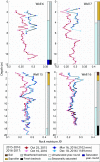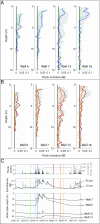Direct observations of rock moisture, a hidden component of the hydrologic cycle
- PMID: 29490920
- PMCID: PMC5856562
- DOI: 10.1073/pnas.1800141115
Direct observations of rock moisture, a hidden component of the hydrologic cycle
Abstract
Recent theory and field observations suggest that a systematically varying weathering zone, that can be tens of meters thick, commonly develops in the bedrock underlying hillslopes. Weathering turns otherwise poorly conductive bedrock into a dynamic water storage reservoir. Infiltrating precipitation typically will pass through unsaturated weathered bedrock before reaching groundwater and running off to streams. This invisible and difficult to access unsaturated zone is virtually unexplored compared with the surface soil mantle. We have proposed the term "rock moisture" to describe the exchangeable water stored in the unsaturated zone in weathered bedrock, purposely choosing a term parallel to, but distinct from, soil moisture, because weathered bedrock is a distinctly different material that is distributed across landscapes independently of soil thickness. Here, we report a multiyear intensive campaign of quantifying rock moisture across a hillslope underlain by a thick weathered bedrock zone using repeat neutron probe measurements in a suite of boreholes. Rock moisture storage accumulates in the wet season, reaches a characteristic upper value, and rapidly passes any additional rainfall downward to groundwater. Hence, rock moisture storage mediates the initiation and magnitude of recharge and runoff. In the dry season, rock moisture storage is gradually depleted by trees for transpiration, leading to a common lower value at the end of the dry season. Up to 27% of the annual rainfall is seasonally stored as rock moisture. Significant rock moisture storage is likely common, and yet it is missing from hydrologic and land-surface models used to predict regional and global climate.
Keywords: Critical Zone; deep vadose zone; evapotranspiration; rock moisture; water budget.
Conflict of interest statement
The authors declare no conflict of interest.
Figures




References
-
- Matthes JH, Goring S, Williams JW, Dietze MC. Benchmarking historical CMIP5 plant functional types across the Upper Midwest and Northeastern United States. J Geophys Res Biogeosci. 2016;121:523–535.
-
- Matheny AM, et al. Characterizing the diurnal patterns of errors in the prediction of evapotranspiration by several land-surface models: An NACP analysis. J Geophys Res Biogeosci. 2014;119:1458–1473.
-
- McColl KA, et al. The global distribution and dynamics of surface soil moisture. Nat Geosci. 2017;10:100–104.
-
- Ochsner TE, et al. State of the art in large-scale soil moisture monitoring. Soil Sci Soc Am J. 2013;77:1888–1919.
Publication types
LinkOut - more resources
Full Text Sources
Other Literature Sources

